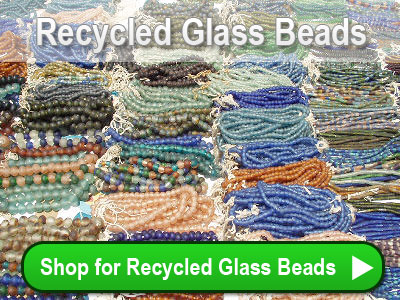What are Recycled Glass Beads?
Glass is one hundred percent recyclable. Once the glass is crushed, it returns to its natural inert and non-toxic state. This is because the ingredients of the glass, silica sand, limestone and soda ash, are inert and non-toxic. Recycling is important because the space taken up by landfills is reduced, recycling glass is cheaper than making new glass, and you save the environment because there are fewer emissions with recycling. Recycling glass reduces the demand for raw materials. Although there is no shortage yet, recycling leaves raw material for future generations.
Recycled glass beads are in high demand because every bead is unique. This is because traditional methods are still used and the painting is done individually. The high demand is also from the fact that people are beginning to care about the environment and the beads are a sign of this. Recycled glass beads are cheaper than beads made from new glass. The glass beads are usually made in developing countries such as Indonesia and some African countries through an initiative called fair trade. This attracts people who want to participate in reducing poverty levels in the developing counties.
The process of making recycled glass beads varies from one region to the other. This means recycled glass beads are different in size, shape, color, and other aspects. The first step in making recycled glass beads is to collect bottles and to sort them according to their color. The glass beads are then crushed into powder form. This is done using mortar and pestle, but for large scale production, the crushing is done using machines.
After the crushing, the fritt is poured into molds and heated until it is ductile enough to work on. The molds are usually made from clay, but in cases where they are not, they are covered with clay to prevent sticking.
There are several ways of perforating the recycled glass beads. In one method, the hot glass is wound around a steel wire that is coated in ‘bead release’, which is a clay slip. After the bead has cooled, the wire is pulled off. In another method, cassava sticks or other sticks are incorporated in the fritt. The sticks are burnt off during the firing process, thereby leaving a hole in the bead. In another method, the hole is created after the baking process by piercing the hot glass with a metal tool.
There are many methods of shaping the recycled glass beads. In one method, the hot glass is shaped while it is in the ‘bead release’. This is done by manipulating it with wood, stainless steel, granite, and tools made from other materials. This is called ‘marvering’, from ‘marver’, which is a French word meaning marble. Another method is pressing the mold while it is still molten. Yet another method is taking the semi-cooled glass using tools that look like ice picks and pressing it on the ground to give it its shape. Molding is used to make Faceted recycled glass beads.
Decorations are made after the beads have been cooled and washed. The decorations are made using fine rods, or stringers. The painting is done using a paste made from a mixture of water and colored glass powder. The recycled glass beads are then re-baked for the décor to be permanent. In most cases, different colors are used in the same bead.
Note that some glass beads are sold are recycled while they are not. To make sure you are buying recycled beads, only buy from well established stores. Check the source before purchase. If possible, have a jeweler check the beads for you. Better still, you can order the beads straight from where they are being made. We recommend purchasing Fair Trade beads to ensure that the artists who make your beads are not being exploited. For people looking to purchase in bulk, check to see if the seller offers wholesale discounts for bulk purchase.
